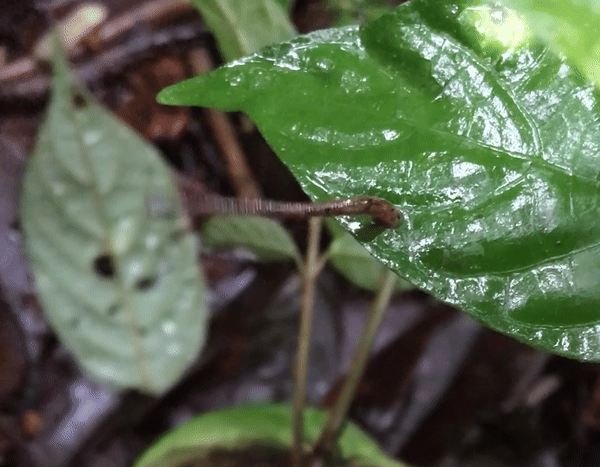Animals
Meet the Rare, 'Beautiful' Birds That Thrive in Snow and Are at Risk Because of Climate Change
The U.S. Fish and Wildlife Service listed the Mount Rainier white-tailed ptarmigan as threatened under the Endangered Species Act this month
When It Comes to Romantic Gift-Giving, Humans Aren’t Alone. Snails, Birds and Flies All Woo Each Other With Presents
Throughout the animal kingdom, sweethearts bestow offerings with their amorous advances
Ancient DNA Unravels the Mysteries of the Dingo, Australia's Wild Dog
Researchers dove into thousands of years of evolutionary history, revealing new insights about the iconic, though sometimes vilified, canines
View 11 Breathtaking Images From the BigPicture Photography Competition
This 2024 showcase of life on Earth shines a light on some of our planet's most amazing species and places
Meet the Taxidermists Who Care for the Animals at Your Favorite Museums
Only a few U.S. museums still employ the specialists. The rest rely on a small group of highly skilled contractors
Carpenter Ants Perform Life-Saving Amputations to Treat Leg Injuries
A new study provides the first evidence of non-human animals performing amputations on others to improve their odds of survival
How Deep-Sea Comb Jellies Hold Their Shape Under Crushing Pressure
The delicate sea creatures fall apart when brought to the surface but can survive miles deep in the ocean due to special cell wall structures, according to a new study
The Quest to Resurrect a Lost Ecosystem in Siberia
A father-and-son team of scientists are trying to revive ancient grasslands by reintroducing large grazers
Charlotte the 'Pregnant Virgin' Stingray Dies After Diagnosis of Reproductive Disease
The animal drew attention earlier this year for becoming pregnant despite having no male ray in her tank
Two Pandas Arrive at the San Diego Zoo, the First to Enter the U.S. in 21 Years
For months, the only pandas in the country had been in Atlanta. Next, San Francisco and Washington, D.C., are expected to also receive pandas this year
Volcanic Ash Preserved Trilobite Fossils in Surprising Detail at 'Prehistoric Pompeii'
The specimens date to more than 500 million years ago and provide new insights into trilobite anatomy, revealing previously unseen features
What Killed the Last Woolly Mammoths? Scientists Say It Wasn't Inbreeding
New research suggests some catastrophic event—such as a natural disaster or a virus—killed the world's last known population of mammoths on Wrangel Island
'Frog Saunas' May Be the Key to Saving Amphibians From a Deadly Fungal Infection
Providing frogs with sun-warmed bricks inside mini-greenhouses can help them recover from chytrid and make them more resilient against the disease in the future, a new study finds
Tasmania Is Hiring for a 'Wombat Walker' and Other Odd Jobs
The Australian island state is trying to drum up tourism during the Southern Hemisphere's winter
Honeybees Can Sniff Out Lung Cancer, Scientists Suggest
New research opens the door for doctors to one day use bees as a living diagnostic tool
Five Amazing Dolphin Behaviors, Explained
From calling each other by name to using tools, these social creatures are a lot like us
These Stunning Butterflies Flew 2,600 Miles Across the Atlantic Ocean Without Stopping
Researchers combined several lines of evidence to solve the mystery of why a group of painted ladies, which do not live in South America, were found fluttering on a beach in French Guiana
The World's Tallest Male Dog Dies Days After Receiving the Record
Kevin, a Great Dane, measured over three feet tall—about the same size as an average 3-year-old child
Chimpanzees May Self-Medicate With Plants, Using the Forest as a Pharmacy
New research suggests sick chimps seek out and eat plants with antibacterial and anti-inflammatory properties—a finding that could advance drug discovery for humans
Watch Blood-Sucking Leeches Leap From Leaves and Soar Through the Air
New videos may help settle scientists' long-standing debate over whether leeches can jump
Page 2 of 184
:focal(1034x673:1035x674)/https://tf-cmsv2-smithsonianmag-media.s3.amazonaws.com/filer_public/a2/8f/a28f6780-212f-412e-a062-d0f87d90ec3d/53058740798_47adf1e29c_k.jpg)
/https://tf-cmsv2-smithsonianmag-media.s3.amazonaws.com/filer/15/bf/15bf2e71-416c-4bfc-929a-a69e4d9253b7/istock-185090020.jpg)
:focal(1067x701:1068x702)/https://tf-cmsv2-smithsonianmag-media.s3.amazonaws.com/filer_public/f4/d0/f4d0fb37-4f26-455a-a8c4-ada959fa2a8a/gettyimages-80254810.jpg)
:focal(800x602:801x603)/https://tf-cmsv2-smithsonianmag-media.s3.amazonaws.com/filer_public/5a/a5/5aa55264-6de9-4220-a710-4a7c4e14a875/main_6-winged_winner_francobanfi.jpg)
:focal(800x602:801x603)/https://tf-cmsv2-smithsonianmag-media.s3.amazonaws.com/filer_public/af/4d/af4dd811-5ca0-4ba2-ba6c-7b5bd9b2e6c5/hall_of_birds.jpg)
:focal(350x297:351x298)/https://tf-cmsv2-smithsonianmag-media.s3.amazonaws.com/filer_public/24/49/24499a13-136e-448c-b662-f611f6d0f795/low-res_video_still_image__woundcare_and_amputation_in_c_maculatus_credit_danny_buffat.jpg)
:focal(1060x713:1061x714)/https://tf-cmsv2-smithsonianmag-media.s3.amazonaws.com/filer_public/78/11/7811e0eb-8364-458a-a9b4-14a582663169/gettyimages-90050101.jpg)
:focal(800x602:801x603)/https://tf-cmsv2-smithsonianmag-media.s3.amazonaws.com/filer_public/5a/5b/5a5bc419-f87d-45f4-9933-8b678752167a/gettyimages-625197012_web.jpg)
:focal(1024x770:1025x771)/https://tf-cmsv2-smithsonianmag-media.s3.amazonaws.com/filer_public/29/a1/29a10843-cb53-4808-b49a-fd229a727237/430063553_706533311658853_4996824608781781526_n.jpg)
:focal(1100x744:1101x745)/https://tf-cmsv2-smithsonianmag-media.s3.amazonaws.com/filer_public/cd/40/cd405d6b-52eb-44e6-bab1-a7d76cb56b6f/yun_chuan_01.jpg)
:focal(350x350:351x351)/https://tf-cmsv2-smithsonianmag-media.s3.amazonaws.com/filer_public/3b/d8/3bd8a090-c6cb-4f86-9820-d4fab0c6ba7a/trilobite.jpg)
:focal(1280x817:1281x818)/https://tf-cmsv2-smithsonianmag-media.s3.amazonaws.com/filer_public/03/54/0354cbb8-1c5f-4d56-856b-1789f070550b/mammoth-tusk-on-wrangel-island-2017-photo-love-dalen-scaled.jpg)
:focal(446x286:447x287)/https://tf-cmsv2-smithsonianmag-media.s3.amazonaws.com/filer_public/f9/f7/f9f713b6-b855-4bb0-8ea6-387a1c2da7a3/green-gold-bell-frogs-waddle-1200.jpg)
![The "wombat walker" will "coax [the wombats] out of bed to get them moving" and "[motivate] them to complete their morning walks."](https://th-thumbnailer.cdn-si-edu.com/V5ZUr7rLp-eP9YgNnHuLHpuAR8g=/400x300/filters:no_upscale():focal(2128x1419:2129x1420)/https://tf-cmsv2-smithsonianmag-media.s3.amazonaws.com/filer_public/66/02/66024570-77c5-4f04-b2b1-13eea82f13c6/gettyimages-173872734.jpg)
:focal(1024x683:1025x684)/https://tf-cmsv2-smithsonianmag-media.s3.amazonaws.com/filer_public/94/10/9410cbf2-768e-4115-8542-924193a2ee66/2048px-honey_bee_apis_mellifera.jpeg)
:focal(800x602:801x603)/https://tf-cmsv2-smithsonianmag-media.s3.amazonaws.com/filer_public/00/be/00beb571-3e79-433a-8267-2d246141493c/gettyimages-1217614729_web.jpg)
:focal(2117x1250:2118x1251)/https://tf-cmsv2-smithsonianmag-media.s3.amazonaws.com/filer_public/b0/c3/b0c341da-9979-4fef-8ae7-1865608d7fe4/una_mariposa_cardera_a_punto_de_emprender_el_vuelo_autor_roger_vila.jpg)
:focal(1000x752:1001x753)/https://tf-cmsv2-smithsonianmag-media.s3.amazonaws.com/filer_public/e7/a6/e7a63854-7c54-41bc-84ad-feb6f4328465/kevin.jpg)
:focal(2568x1712:2569x1713)/https://tf-cmsv2-smithsonianmag-media.s3.amazonaws.com/filer_public/0d/00/0d00e8c6-566a-4abc-8a18-1b04d9ef5e3b/gettyimages-200207474-001.jpg)
